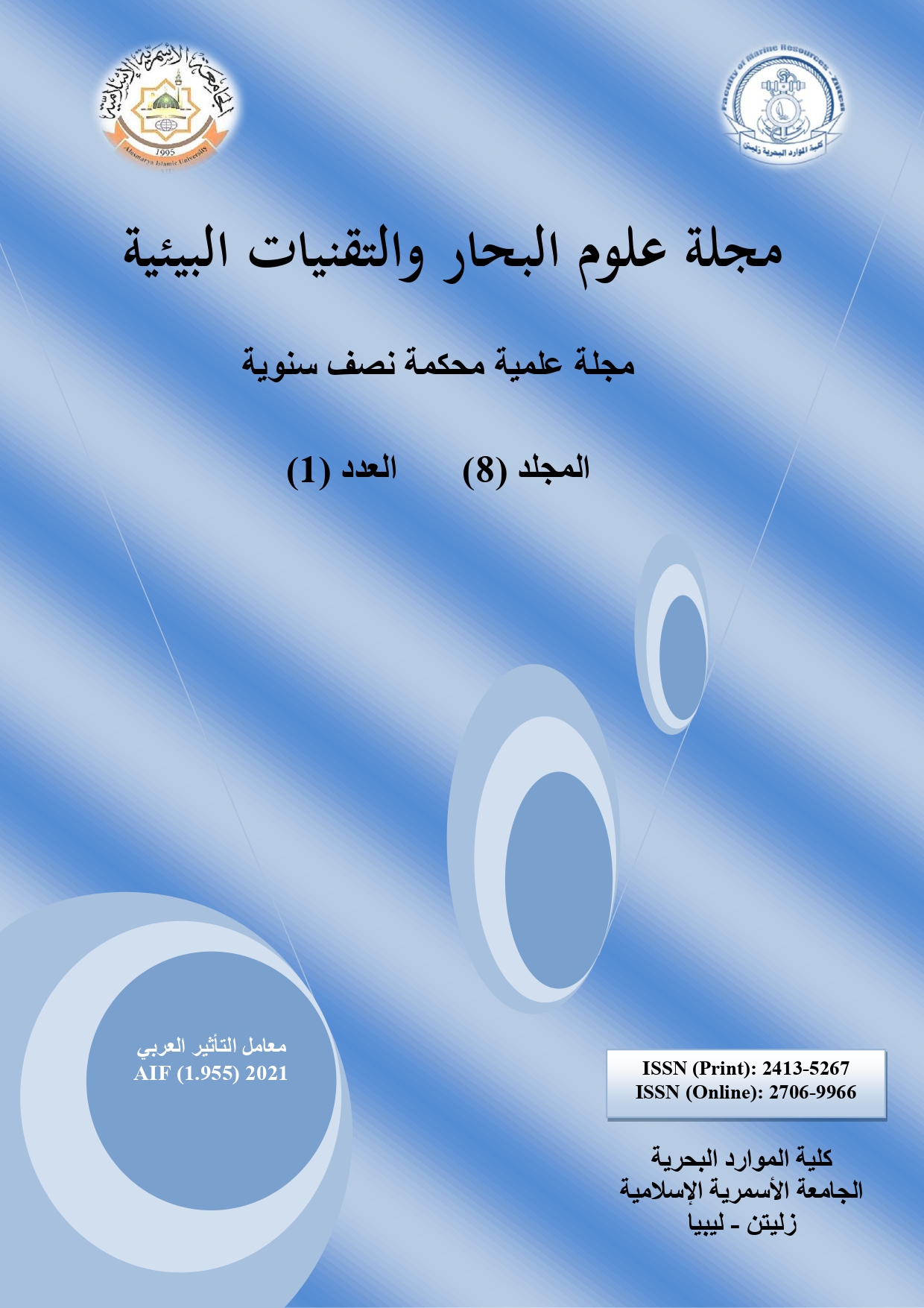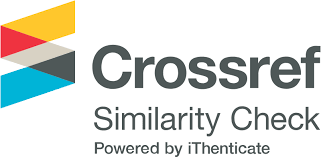تقدير مستوى التلوث للبيئة البحرية باستخدام مؤشر حمل التلوث
DOI:
https://doi.org/10.59743/jmset.v8i1.5الكلمات المفتاحية:
المعادن الثقيلة، رصد البيئة المائية، أولفا، إنتيرومورفا، مؤشرات التلوث، جودة حالة النظام البيئي البحريالملخص
المراقبة تعني مراقبة البيانات، المؤشرات، التقييم والمعرفة. تأسيساً على ذلك، فإن مؤشر حمل التلوث تم تطبيقه أو حسابه باستخدام البيانات والنتائج المتحصل عليها لتركيز المعادن الثقيلة في عينات من مياه البحر وكذلك عينات من نوعين من الطحالب الخضراء وهما الأولفا والانتروموفا. تم اعتبار الطحالب وPosidonia oceanic مرشحين جيدين من بين الأنواع المختلفة التي اختارها برنامج الأمم المتحدة للبيئة (UNEP). تم قياس تراكيز المعادن (الزنك، الرصاص، الكادميوم، والنحاس) في طحالب بحرية خضراء هما Ulva sp وEnteromorpha sp، تم جمعهما من أربعة مواقع خلال فصلي الشتاء والصيف. أظهرت نتائج PLI المحسوبة أن قيم Enteromorpha كانت 1.2 تشير إلى حالة ملوثة بينما كانت قيم PLI لأنواع Ulva 3.3. فيما يتعلق بالموقع B (منطقة جوليانا)، تم العثور على قيمة PLI لأنواع Ulva لتكون 4.1 تشير إلى حالة مقبولة بينما كانت حالة نظيفة لأنواع Enteromorpha في نفس المواقع. تعتبر أنواع Enteromorpha تراكمًا جيدًا للمعادن الثقيلة ويمكن أن تكون أيضًا مرشحًا جيدًا لمراقبة الساحل الليبي. تظهر النتائج أيضًا أن مؤشر PLI يمكن أن يكون أداة مهمة لتقييم البيئة البحرية.
التنزيلات
المراجع
Antonious G.F., Dennis S.O., Unrine J.M., & Snyder J.C. (2011). Heavy metals uptake in plant parts of sweet potato grown in soil fertilized with municipal sewage sludge. International journal of Geology, 5(1): 14-20..
Barinova S. (2017). On the classification of water quality from an ecological point of view. International Journal of Environmental Sciences & Natural Resources, 2(2): 1-8.
Cho J., Hyun S., Han J.H., Kim S., & Shin D.H. (2015). Historical trend in heavy metal pollution in core sediments from the Masan Bay, Korea. Marine Pollution Bulletin, 95(1): 427-432.
Chung S.Y., Venkatramanan S., Park N., Ramkumar T., Sujitha S.B., & Jonathan M.P. (2016). Evaluation of physico-chemical parameters in water and total heavy metals in sediments at Nakdong River Basin, Korea. Environmental Earth Sciences, 75(1): 1-12.
EL-Bady M.S. & Metwally H.I. (2013). Geochemistry and environmental assessment of heavy metals pollution in bottom sediments of Damietta Nile branch, Egypt. Egypt. J. Geol, 57: 131-144.
Gashi F., Frančišković-Bilinski S., Bilinski H., Shala A., & Gashi A. (2017). Impact of Kishnica and Badovci flotation tailing Dams on levels of heavy metals in water of Graçanica river (Kosovo). Journal of Chemistry, Article ID: 5172647.
Ghaleno O.R., Sayadi, M.H., & Rezaei M.R. (2015). Potential ecological risk assessment of heavy metals in sediments of water reservoir case study: Chah Nimeh of Sistan. Proceedings of the International Academy of Ecology and Environmental Sciences, 5(3): 89-96.
Ho Y.B. (1990). Ulva lactuca as bioindicator of metal contamination in intertidal waters in Hong Kong’. Hydrobiologia, 203(1): 73-81.
Islam M.S., Ahmed M.K., Raknuzzaman M., Habibullah-Al-Mamun M., and Islam M.K. (2015). Heavy metal pollution in surface water and sediment: a preliminary assessment of an urban river in a developing country. Ecological Indicators, 48: 282-291.
Jeffrey D.W., Wilson J.G., Harris C.R., & Tomlinson D.L. (1985). The application of two simple indices to Irish estuary pollution status. In: Estuarine management and quality assessment (pp. 147-161), Springer, Boston, MA.
Karbassi A.R., Monavari S.M., Nabi Bidhendi G.R., Nouri J., & Nematpour K. (2008). Metal pollution assessment of sediment and water in the Shur River. Environmental monitoring and assessment, 147(1): 107-116.
Kim K.T., Ra K., Kim E.S., Yim U.H., & Kim J.K. (2011). Distribution of heavy metals in the surface sediments of the Han River and its estuary, Korea. Journal of Coastal Research, 903-907.
Kolkwitz R. & Marsson M. (1908). Ökologie der flanzliche saprobien. Berichte der Deutschen Botanischen Gesellschaft, 26: 505-519.
Kowalska J.B., Mazurek R., Gąsiorek M., & Zaleski T. (2018). Pollution indices as useful tools for the comprehensive evaluation of the degree of soil contamination–A review. Environmental Geochemistry and Health, 40(6): 2395-2420.
Kshirsagar A.D. (2013). Use of Algae as a Bioindicator to Determine Water Quality of River Mula from Pune City, Maharashtra (India). Universal Journal of Environmental Research & Technology, 3(1): 79-85.
Lai T.M., Lee W., Hur J., Kim Y., Huh I., Shin H.S., Kim C.K., & Lee J. H. (2013). Influence of sediment grain size and land use on the distributions of heavy metals in sediments of the Han River Basin in Korea and the assessment of anthropogenic pollution. Water, Air, & Soil Pollution, 224(7): 1-12.
Liu X., Jiang J., Yan Y., Dai Y.Y., Deng B., Ding S., Su S., Sun W., Li Z., and Gan Z. (2018). Distribution and risk assessment of metals in water, sediments, and wild fish from Jinjiang River in Chengdu, China. Chemosphere, 196: 45-52.
Tomlinson D.L., Wilson J.G., Harris C.R., & Jeffrey D.W. (1980). Problems in the assessment of heavy-metal levels in estuaries and the formation of a pollution index. Helgoländer Meeresuntersuchungen, 33(1): 566-575.
التنزيلات
منشور
إصدار
القسم
الرخصة
الحقوق الفكرية (c) 2022 مجلة علوم البحار والتقنيات البيئية

هذا العمل مرخص بموجب Creative Commons Attribution 4.0 International License.












